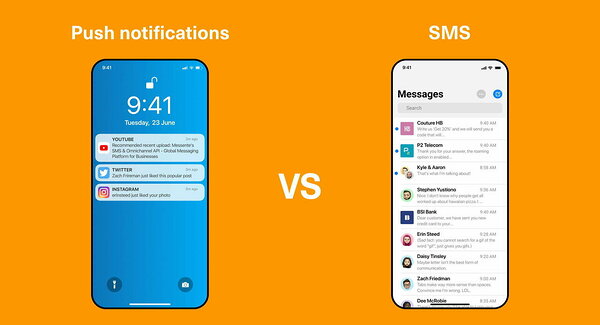With many users checking their mobile devices on and off daily (Americans do this 96 times a day), it's clear that one of the best ways to reach customers is by sending SMS messages or push notifications to their phones.
On the face of it, push notifications and SMS appear very similar. But actually, there are some key differences between them that matter in terms of your business marketing goals and user engagement metrics.
This article sets out everything you need to know so you can work out which communication channel – SMS messaging or push notification– offers the best fit for your needs.
What are SMS notifications?
First of all, let's have a little refresher as to what SMS is all about. SMS stands for 'Short Message Service'. An SMS notification is the same thing as a text message, which anyone with a mobile phone will be familiar with, as they'll have a native text messaging mobile app on their device.
Text messages can contain up to 160 characters. If this limit is exceeded, it counts as an additional message, which is something to be aware of when mass texting as the costs can soon add up. They can be either one-way or two-way messages (the latter being where the recipient is able to text you as well).
In business, you can use texts to send marketing messages like flash sale notifications, discount codes, quick surveys and product review requests. You can include a link with your text with a preview option that displays image content.
SMS messages are also used for transactional communications, like PIN codes (to help customers log in to their online accounts), order confirmations, delivery updates and appointment reminders.
Here’s an example of an SMS notification arriving in the notification panel.
What is a push notification?
Push notifications are a type of one-way communication that pops up on a user's mobile phone or desktop device. They are 'pushed through' a third-party application that the user has downloaded. There are two types – mobile push notifications and web push notifications.
You can have a title, separate message copy and even a small image or icon within a push notification. A title length of 39 characters and 150 for the message itself is an optimal limit to achieve the best display results across most devices. Here's an example of a push notification sent by Twitter:
The key differences between push notifications vs SMS
Aside from different character limits and design capabilities, there are a few important differences to note between these two types of communications.1. The opt-in process
The first point is around how users opt-in to receive push notifications and SMS. For example, with push notifications, users can easily give and withdraw permission within the third-party app on their mobile device. On websites, this is done via a popup form that asks users visiting for the first time to allow (or block) notifications.
In order for users to receive SMS marketing messages, you first need to get express written consent – and collect phone numbers. A good way to do this is by asking users to send an opt-in text to subscribe to marketing texts. Many businesses do this by displaying a notice that says something like:
Want to be the first to know about our latest deals and special offers? Send a text to [12345] with the keyword 'SUBSCRIBE' to receive our SMS marketing campaigns.
Once you're sending SMS text messages to subscribers, you also need to give them an easy way to opt out of future campaigns. You can do this by adding an unsubscribe link that the user can simply click onto, or by asking them to text a keyword, e.g., STOP. (This only works if you have two-way text messaging set up, however.)
The opt-in/opt-out process is generally less complicated with push notifications than with SMS because the user is only required to share very limited personal data (such as their IP address). You don't need to get express written consent and the user has easier control over permissions.
2. Method of delivery
SMS text messages are delivered over a cellular network (not the internet) directly to mobile phones. This means that it's possible to deliver text messages even when there's no Wi-Fi signal – and to basic cell phones, not just smartphones.
On the other hand, push notifications are delivered via an application that relies on the internet, and they can only be delivered to smartphone users that have downloaded the app in question. Push messages only appear once the user is connected to the internet (although the application itself doesn't need to remain open on the user's mobile device).
If you need to send an urgent or time-sensitive message, it's best to use the fastest, most reliable and most accessible channel for deliverability – that's SMS.
3. Impact
Visibility is another key difference between push notifications and SMS. Push notifications are typically highly visible; they usually arrive with a sound alert and slide into view. But if the user chooses to ignore notifications for a while, more can arrive, pushing the first notification further down the stack, where it can get lost among the other messages.
In this example below, you can just about see tiny icons from BBC News and the low-cost shopping app, Wish, right at the bottom. These notifications are practically hidden. They will slide into view once the user deletes the messages from Google and Twitter, but their effectiveness is somewhat diluted.
To remove push notifications from view, the user simply swipes right on their mobile screen. It disappears permanently at this point and can't be retrieved.
SMS text messages arrive in a similar fashion to push notifications – they flash up on the lock screen with a sound alert. They arrive virtually instantly, as long as the subscriber has a phone signal. When SMS notifications are swiped, they disappear from view but remain in the SMS inbox, where the subscriber can read them again if they want to.
An SMS text message is harder to ignore than a push notification, for the primary reason that texts are familiar to us – we get them from family, friends and businesses that we're happy to hand our phone number out to. Open rates for text messages are 98%, which confirms that SMS is a highly visible marketing channel.
Furthermore, SMS is an underused marketing channel compared to push notifications. The latter is widely used, so much so, that the average U.S. smartphone user gets 46 push notifications every day, which is pure bombardment. It's no wonder then this survey reported that 43% of consumers disable push notifications if they start getting between two and five a week.
When to send push notifications vs text messages
Which channel to choose really depends on your business and messaging needs. For instance, if you offer an app-based product or service, and need to alert users about developments, support or promotions, then push notifications will do the job nicely.
E-commerce businesses will also find push notifications a very useful marketing tool because they can be used for abandoned cart alerts and product recommendations as well as general store promotions and announcements.
SMS is best used for messages that absolutely must be delivered, like booking confirmations, appointment reminders, two-factor authentication, and even emergency alerts. That said, SMS is often used for marketing purposes because it's a great channel for impact – texts are best for grabbing attention.
How to send effective SMS notifications
When sending SMS notifications, you have a very small window – quite literally! – to connect with your target audience. Each of the marketing messages has to be phrased right, timed perfectly, and speak to the recipient, all while staying within the character limit.
Here are a few tips and tricks to keep in mind when composing and sending out an informative and useful SMS notification message.
1. Use a proper Sender ID
Always use sender names, phone numbers or short codes that are connected to your business or brand. It is advised to use sender names when you don't expect or want the customer to reply. A branded sender name will ensure that the customer knows that the messages are coming from you and thus, they can trust the information written in the message body.
Let the message receiver know your phone numbers or short codes if you plan to use them, so they know it is you and try to avoid randomly generated senders.
2. Add interactive elements to SMS notifications
Due to the extremely limited length of an SMS, it can be pretty difficult to try and fit all the necessary information within a single 160-character text body. This opens the perfect opportunity to make your notification interactive, encouraging the user to take some sort of action after receiving your text.
You can make your notification messages more interactive by adding clickable mobile-friendly links to your website. This way, you can elaborate on the message content or details of the notification without expanding the SMS content and consequently doubling or tripling the cost.
Here's an example:
“Hi Bill, your booking number is 12345, you can view your booking documents here: m.airline.com/booking12345. Kind Regards Your Airlines”
The example message is 135 characters long, so there’s even room to spare. You can use our SMS Length Calculator to be sure that you don't go over the character limit.
3. Personalize your SMS notifications
Add the message recipient's first name or other personal information in the text body. This way, the SMS notifications will look less like an automatically generated, robotic, spam piece of data and more like a friendly message from someone they know.
Personalization goes beyond adding your customers' names to text messages; it also involves taking into consideration each user's behaviour and engagement and subsequently modifying the content that you send to them.
The more personalized the SMS notifications, the more relevant they will be, and the higher the chances of your users being satisfied with your brand's voice. Building an emotional connection with your customer will make your message notifications much more impactful too.
Here’s an example:
“Dear Jane, due to fog, your flight from Heathrow to Amsterdam leaving at 11h00, is delayed until 13h30. We apologize for the inconvenience. Your Airlines”
4. Add your contact details to your text messages
Give the message receiver the possibility to get back in touch with you by adding customer support details such as phone numbers or an email address to the SMS message. This ensures that they know where to turn to in case they have any questions.
Another way to encourage user response is to add links that take users to a webpage where they can fill out a form. If you are sending an appointment reminder or confirmation text, for example, you can add a link to a calendar where the customer can change their appointment details to reschedule.
Like
this:
“Hi Jill, your appointment with Dr
Teeth is at 10.00am tomorrow. To reschedule go to bit.ly/drteetapp or call +23
57848321. Kind regards Dr Teeth and Co”
Getting started with SMS and push notifications
The first step to getting started with SMS messages or push notifications is to select a provider. The internet is your oyster for finding one.
There are certain things to look out for when researching the best provider. For both channels, check for ease of implementation, user-friendliness, core and advanced features, message delivery rate and the support level. A free trial is essential so you can try out the provider's platform and service before you commit to spending money.
Here at Messente, we offer a global SMS API to help you directly reach your customers with business-critical PIN codes, notifications and marketing messages (in over 190 countries).
To try Messente out for yourself, sign up here for free and send your first few text messages at no cost.








